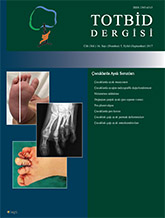
Pes cavus is characterized with high medial longitudinal arch. It is usually associated with hereditary motor sensorial neuropathies but cerebral palsy, spinal cord injuries, trauma, pes equinovarus sequel are among the known causes. Although the causes of cavovarus foot differs, deformity occurs as a result of the imbalance among muscle powers. Strong peroneus longus and tibialis posterior muscles bring the hindfoot into varus and hyperplantarflex the first ray. The deformity may be flexible at the beginning but with time, it becomes rigid and may result with instability at the ankle, pain over the lateral border of the foot and joint degeneration. Physical examination should include a detailed neurological examination, muscle power assessment and joint range of motion measurements. Flexibility of the deformity can be assessed with Coleman block test, and treatment can be planned with the help of physical examination findings. In the earlier phases of the deformity, patients can be followed conservatively but deforming forces must be balanced in order to prevent inadvertent deformities. Tendon transfers, osteotomies and in advanced grade rigid deformities arthrodesis can be used in surgical treatment.